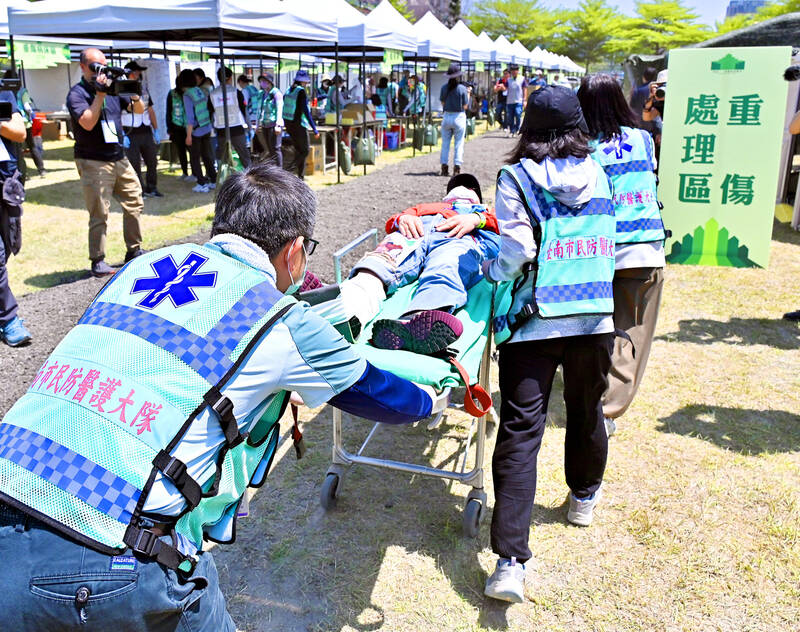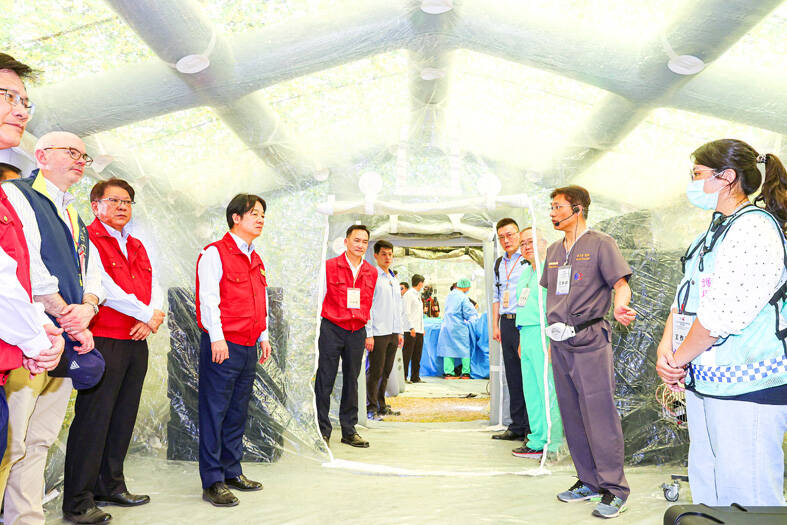President William Lai (賴清德) yesterday oversaw the first civil defense drills under his newly created social resilience committee simulating how to respond to a large-scale disaster such as a tsunami or attacks on critical infrastructure.
The drill in Tainan was held under the auspices of Lai’s new Whole-of-Society Defense Resilience Committee, set up last year to prepare to deal with natural disasters or other emergencies such as an attack by China.
Speaking to participants after viewing some of the drills, Lai said these were the first live drills for the committee and involved about 1,500 people, adding that there would be more next month.

Photo: Tu Chien-jung, Taipei Times
“The aim is to build the resilience of Taiwanese society to cope with large natural disasters or major accidents that cause a lot of injuries, or regional geopolitical changes. We dare not fail to prepare,” he added.
“As the saying goes, prevention is better than cure and we should rely not on the likelihood of the enemy not coming, but on our own readiness to receive him,” Lai said.
“We hope that through strength, not only of the military, but also the resilience of the entire society in defense, we can ensure Taiwan’s security and ensure that peace can be achieved through the demonstration of our strength,” he added.

Photo: CNA
Shortly after Lai spoke, the Ministry of National Defense said China yesterday held another “joint combat readiness patrol” around the nation with 28 fighter jets, drones and other aircraft, as well as warships.
The Tainan drills simulated scenarios such as a tsunami after a massive offshore earthquake and “explosions” at a passenger port terminal, evacuating casualties to triage centers and setting up emergency response command posts.
The drill was carried out based on a scenario in which an explosion occurred near the tourist service center at Anping Port (安平港), with an estimated 200 casualties at the scene.
Under tents, casualties were laid out on the ground and treated, as other officials used large whiteboards to keep track of their care and who had died or the level of injuries.
About 1,500 people were mobilized — including police officers, a special team from Anping Harbor, volunteers organized by local police stations and fire departments, and members of charity groups and businesses — to work alongside alternative service conscripts in the operation.
While the military, which is at the front lines of helping deal with actual disasters such as earthquakes, was not directly involved, the armed forces did lend equipment to set up outside operating theaters and other medical equipment.
Also in attendance and observing the drills were Vice President Hsiao Bi-khim (蕭美琴) and representatives from 13 governments, including the US, EU, Polish, Finnish and Indian representatives to Taiwan, among other senior foreign diplomats from the UK, Singapore, Japan, Israel, Canada and Australia.
American Institute in Taiwan Director Raymond Greene praised the performance in a statement.
“I was impressed to see community members, first responders, city officials and Taiwan’s central authorities unite and demonstrate the resolve and strength of the people in Taiwan to face future challenges,” he said.
Additional reporting by Kayleigh Madjar and CNA

The US government has signed defense cooperation agreements with Japan and the Philippines to boost the deterrence capabilities of countries in the first island chain, a report by the National Security Bureau (NSB) showed. The main countries on the first island chain include the two nations and Taiwan. The bureau is to present the report at a meeting of the legislature’s Foreign Affairs and National Defense Committee tomorrow. The US military has deployed Typhon missile systems to Japan’s Yamaguchi Prefecture and Zambales province in the Philippines during their joint military exercises. It has also installed NMESIS anti-ship systems in Japan’s Okinawa

TRAGEDY STRIKES TAIPEI: The suspect died after falling off a building after he threw smoke grenades into Taipei Main Station and went on a killing spree in Zhongshan A 27-year-old suspect allegedly threw smoke grenades in Taipei Main Station and then proceeded to Zhongshan MRT Station in a random killing spree that resulted in the death of the suspect and two other civilians, and seven injured, including one in critical condition, as of press time last night. The suspect, identified as a man surnamed Chang Wen (張文), allegedly began the attack at Taipei Main Station, the Taipei Fire Department said, adding that it received a report at 5:24pm that smoke grenades had been thrown in the station. One man in his 50s was rushed to hospital after a cardiac arrest

‘WIN-WIN’: The Philippines, and central and eastern European countries are important potential drone cooperation partners, Minister of Foreign Affairs Lin Chia-lung said Minister of Foreign Affairs Lin Chia-lung (林佳龍) in an interview published yesterday confirmed that there are joint ventures between Taiwan and Poland in the drone industry. Lin made the remark in an exclusive interview with the Chinese-language Liberty Times (the Taipei Times’ sister paper). The government-backed Taiwan Excellence Drone International Business Opportunities Alliance and the Polish Chamber of Unmanned Systems on Wednesday last week signed a memorandum of understanding in Poland to develop a “non-China” supply chain for drones and work together on key technologies. Asked if Taiwan prioritized Poland among central and eastern European countries in drone collaboration, Lin

ON ALERT: Taiwan’s partners would issue warnings if China attempted to use Interpol to target Taiwanese, and the global body has mechanisms to prevent it, an official said China has stationed two to four people specializing in Taiwan affairs at its embassies in several democratic countries to monitor and harass Taiwanese, actions that the host nations would not tolerate, National Security Bureau (NSB) Director-General Tsai Ming-yen (蔡明彥) said yesterday. Tsai made the comments at a meeting of the legislature’s Foreign Affairs and National Defense Committee, which asked him and Minister of National Defense Wellington Koo (顧立雄) to report on potential conflicts in the Taiwan Strait and military preparedness. Democratic Progressive Party (DPP) Legislator Michelle Lin (林楚茵) expressed concern that Beijing has posted personnel from China’s Taiwan Affairs Office to its